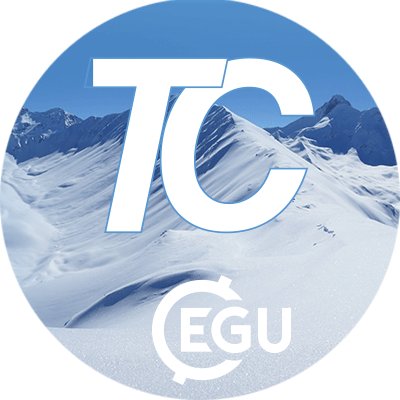
The Cryosphere
@EGU_TC
Followers
5K
Following
164
Media
118
Statuses
5K
This account is no longer maintained. Visit our website at: https://t.co/ws2WfCQmEA
Joined July 2014
Discussion open for comments on @EgUsphere: Spatio-temporal melt and basal channel evolution on Pine Island Glacier ice shelf from CryoSat-2
0
0
0
Discussion open for comments on @EgUsphere: Ice/firn age distribution on the Elbrus Western Plateau (Caucasus) inferred from ice flow model
egusphere.copernicus.org
Abstract. The glaciers of Mount Elbrus (Caucasus) contain paleoclimatic and paleoenvironmental information representative of a vast region. The cold conditions and negligible seasonal melting in the...
0
1
3
New research article: Feature-based comparison of sea ice deformation in lead-permitting sea ice simulations
tc.copernicus.org
Abstract. The sea ice modeling community is progressing towards pan-Arctic simulations that explicitly resolve leads in the simulated sea ice cover. Evaluating these simulations against observations...
0
0
1
New research article: Ice speed of a Greenlandic tidewater glacier modulated by tide, melt, and rain
tc.copernicus.org
Abstract. Ice discharge from the Greenland ice sheet is controlled by tidewater glacier flow speed, which shows large variations on different timescales. Short-term speed variations are key to...
0
0
3
New research article: Subglacial discharge effects on basal melting of a rotating, idealized ice shelf
tc.copernicus.org
Abstract. When subglacial meltwater is discharged into the ocean at the grounding line, it acts as a source of buoyancy, enhancing flow speeds along the ice base that result in higher basal melt...
0
1
1
Discussion open for comments on @EgUsphere: New insights on particle characteristics of previously characterised EGRIP ice core samples via single particle ICP-TOFMS
egusphere.copernicus.org
Abstract. Polar ice cores contain an archive of chemical impurities, which can be used as a proxy for the past climate. State-of-the-art chemical methods increase our knowledge about these impuriti...
0
0
0
Discussion open for comments on @EgUsphere: Modeling L-band Microwave Brightness Temperature Time Series for Firn Aquifers
egusphere.copernicus.org
Abstract. Firn aquifers play an important role in polar ice sheet hydrology and the associated mass and energy transport processes. Although firn aquifer extent has been mapped using passive microw...
0
0
0
Discussion open for comments on @EgUsphere: Modeling the impacts of climate trends and lake formation on the retreat of a tropical Andean glacier (1962–2020)
0
1
1
New research article: Benchmarking passive-microwave-satellite-derived freeze–thaw datasets
0
0
0
Discussion open for comments on @EgUsphere: Will landscape responses reduce glacier sensitivity to climate change in High Mountain Asia?
0
0
0
New research article: Pressurised water flow in fractured permafrost rocks revealed by borehole temperature, electrical resistivity tomography, and piezometric pressure
tc.copernicus.org
Abstract. Rock slope instabilities and failures from permafrost rocks are among the most significant alpine hazards in a changing climate and represent considerable threats to high-alpine infrastru...
0
0
1
New research article: Separating snow and ice melt using water stable isotopes and glacio-hydrological modelling: towards improving the application of isotope analyses in highly glacierized catchments
tc.copernicus.org
Abstract. Glacio-hydrological models are widely used for estimating current and future streamflow across spatial scales, utilizing various data sources, notably observed streamflow and snow and/or...
0
0
2
New research article: High-resolution 4D electrical resistivity tomography and below-ground point sensor monitoring of High Arctic deglaciated sediments capture zero-curtain effects, freeze–thaw transitions, and mid-winter thawing
tc.copernicus.org
Abstract. Arctic regions are under immense pressure from a continuously warming climate. During the winter and shoulder seasons, recently deglaciated sediments are particularly sensitive to human-i...
0
0
1
New article: Brief communication: Monitoring snow depth using small, cheap, and easy-to-deploy snow–ground interface temperature sensors
tc.copernicus.org
Abstract. Temporally continuous snow depth estimates are vital for understanding changing snow patterns and impacts on permafrost in the Arctic. We trained a random forest machine learning model to...
0
3
5
Discussion open for comments on @EgUsphere: Seasonal evolution of the subglacial hydrologic system beneath the western margin of the Greenland Ice Sheet inferred from transient speed-up events
egusphere.copernicus.org
Abstract. The transport of meltwater from the surface to the bed of the Greenland Ice Sheet is well understood to result in elevated surface velocities, although this relationship remains poorly...
0
0
0
New research article: Evidence of active subglacial lakes under a slowly moving coastal region of the Antarctic Ice Sheet
tc.copernicus.org
Abstract. Active subglacial lakes beneath the Antarctic Ice Sheet provide insights into the dynamic subglacial environment, with implications for ice-sheet dynamics and mass balance. Most previously...
0
0
6
New research article: History and dynamics of Fennoscandian Ice Sheet retreat, contemporary ice-dammed lake evolution, and faulting in the Torneträsk area, northwestern Sweden
tc.copernicus.org
Abstract. The prospect of alarming levels of future sea level rise in response to the melting of the Antarctic and Greenland ice sheets affirms an urgency to better understand the dynamics of these...
0
0
0
Discussion open for comments on @EgUsphere: Assessment and comparison of thermal stabilisation measures at an Alpine permafrost site, Switzerland
0
0
3
Discussion open for comments on @EgUsphere: Sub-shelf melt pattern and ice sheet mass loss governed by meltwater flow below ice shelves
0
0
0
Discussion open for comments on @EgUsphere: Folding due to anisotropy in ice, from drill core-scale cloudy bands to km-scale internal reflection horizons
0
0
1











